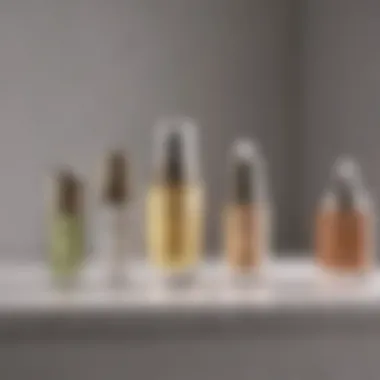Finding the Best Serum for Radiant Skin


Intro
In a world where first impressions often hinge on visuals, the allure of radiant skin cannot be understated. Individuals chase that luminous glow, believing that the right serum can unlock this beauty. However, with an overwhelming array of options available on the market, determining which serum can deliver results tailored to one’s unique needs often feels like a daunting task.
Many factors influence the effectiveness of a skincare serum, from the ingredients used to how they react with individual skin types. For those navigating this landscape, it’s essential first to understand what defines radiant skin and how various products can facilitate that natural glow. By dissecting the critical elements of serums and delineating between skin types, lifestyle influences, and environmental factors, readers can arm themselves with knowledge that goes beyond the labels.
This article beckons you to embark on a quest—equipping you with insights to make informed choices. With proper guidance, you can select serums that work harmoniously with your skin, ultimately leading to the radiant and revitalized appearance you seek.
Tips and How-Tos
Skincare Routines for Different Skin Types
1. Dry Skin:
For those with dry skin, look for serums rich in hyaluronic acid and vitamin E. These ingredients work together to provide moisture and maintain hydration levels. A simple routine might consist of a hydrating cleanser, followed by a nourishing serum, and finished off with a heavier moisturizer to lock in the benefits.
2. Oily Skin:
A lightweight serum featuring salicylic acid can be beneficial for oily skin types. This ingredient helps to control sebum production while keeping the skin balanced. Pair it with a gentle foaming cleanser and an oil-free moisturizer for the best results.
3. Combination Skin:
Balance is key here. A serum that combines ingredients like niacinamide for oil control and squalane for hydration can be excellent. Using different products for different areas may also work. For example, applying specific serums on your T-zone and others on drier areas.
4. Sensitive Skin:
Opt for serums free from fragrances and harsh chemicals. Calming ingredients such as aloe vera and green tea extract can help soothe irritation. This should be complemented with a gentle, non-abrasive cleanser and a moisturizer designed for sensitive skin.
Understanding Ingredient Efficacy
It’s imperative to read beyond the alluring packaging and marketing language. Be aware of the active ingredients in your chosen serum:
- Vitamin C: Brightens the skin and combats dullness.
- Retinol: Proven to reduce signs of aging and improve skin texture.
- Peptides: Support skin repair and firmness.
- Antioxidants: Protect the skin from free radical damage.
Ultimately, knowing what to look for can significantly affect your skin’s overall appearance.
Sustainable Practices
Eco-Friendly Options in Skincare
Amidst the frantic pace of beauty product consumption, a growing interest in sustainability is shaping the skincare industry. Many brands now prioritize eco-friendliness, utilizing recyclable packaging or sourcing biodegradable ingredients. Choosing products from brands that adopt these practices contributes towards a more responsible beauty routine.
Some brands to consider:
- Burt's Bees: Known for using natural ingredients and eco-friendly practices.
- Drunk Elephant: Focuses on clean and safe formulations in sustainable packaging.
Tips for Sustainable Grooming
Adopting sustainable grooming habits goes beyond choosing the right products. Consider the following:
- Reduce Waste: Opt for refillable containers whenever possible.
- Research Brands: Look for companies that practice fair trade and ethical sourcing.
- Minimize Plastic: Consider glass, aluminum, or other sustainable packaging alternatives.
By making conscious choices, each person can play a role in promoting a more sustainable beauty industry.
Celebrating Diversity in Beauty
Inclusive Beauty Brands
As beauty standards shift, numerous brands work to embrace diversity, offering extensive shade ranges and product innovations that cater to all skin tones. Brands like Fenty Beauty and Make Up For Ever have set benchmarks with inclusive offerings that encourage consumers to celebrate their unique beauty.
Cultural Influences on Fashion
Cultural backgrounds often shape our perceptions of beauty. As globalization continues its march, traditional beauty secrets are increasingly recognized. For instance, many cultures prioritize oils and extracts from native plants, often leading to serums that introduce potent botanicals into everyday routines.
"True beauty is about authenticity and embracing what makes each individual unique."
In closing, the journey toward radiant skin is multifaceted and deeply personal. With a proper understanding of serums and the benefits they can bestow, individuals can navigate this vibrant world and make choices that resonate with their skin's needs. Achieving that glow is not just about the product but also about understanding the skin beneath.
Understanding Skin Radiance
When we talk about skin radiance, we're discussing more than just surface-level beauty; it's about the overall health and vitality of the skin. Understanding what contributes to glowing skin is crucial for anyone serious about skincare, particularly women striving for that enviable luminosity. Skin radiance is not solely governed by external applications but also by internal factors and lifestyle choices.
What Constitutes Glowing Skin?


Glowing skin is often described as skin that appears vibrant, healthy, and youthful. Several key factors contribute to this coveted state:
- Hydration: Well-hydrated skin reflects light better, giving it that sought-after glow. It’s essential to drink enough water and employ hydrating products like serums.
- Even Skin Tone: Discoloration or redness can dim your skin's radiance. Products that target uneven skin tone, such as those with Vitamin C, can boost brightness.
- Healthy Skin Barrier: An intact skin barrier keeps moisture in and irritants out. When this barrier is compromised, you may notice a dull appearance.
- Nutrient-Rich Diet: Foods rich in antioxidants, vitamins, and healthy fats contribute to healthier skin. Think avocados, berries, and nuts.
"The way skin reflects light often influences our perception of its health more than any other factor."
The Role of Skincare in Achieving Luminous Skin
Skincare plays a vital part in the pursuit of radiant skin. With a proper routine, individuals can significantly enhance their skin's appearance over time. Here are some considerations:
- Cleansing: A consistent cleansing routine removes impurities and prepares the skin for better absorption of serums and other products.
- Exfoliation: Gentle exfoliating treatments can slough away dead skin cells, promoting cell turnover. This process unveils fresher skin underneath, which naturally appears more luminous.
- Moisturization: A good moisturizer locks in hydration and creates a smooth surface. It’s essential not to skip this step, regardless of your skin type.
- Use of Serums: High-quality serums packed with active ingredients provide a concentrated dose of benefits, targeting specific issues from dullness to hydration.
- Protection: Sunscreen is non-negotiable. UV exposure can cause skin damage, so shielding your skin daily is crucial for maintaining its health and vibrancy.
In summary, understanding skin radiance encompasses various factors from nutrition to skincare routines. By considering these aspects, individuals can begin their journey towards achieving and maintaining that golden glow.
The Science Behind Serums
When it comes to achieving that coveted, luminous complexion, understanding the science behind serums becomes paramount. Serums are often hailed as potent allies in one's skincare arsenal, occupying a unique space between traditional moisturizers and potent actives. They deliver concentrated ingredients that cater to various skin concerns, making them key players in any effective skincare routine. The intricate formulation of serums offers a tailored approach, perfect for addressing problems like dullness, dryness, or signs of aging. By delving deeper into the mechanics of these products, consumers can better appreciate the significant role they play.
What Are Serums and How Do They Work?
At their core, serums are lightweight formulations that carry a high concentration of active ingredients designed to penetrate deeply into the skin. Unlike thicker creams, serums boast smaller molecules that facilitate this deep absorption. But how exactly do they work? The mechanism can be broken down into a few simple points:
- Targeted Delivery: Serums are engineered to deliver specific treatments to distinguish skin issues, making them effective in their action.
- Active Ingredients: Packed with actives such as vitamins, peptides, or antioxidants, these products aim to provide beneficial effects. For instance, Vitamin C in serums promotes brightness while retinol can support cell turnover.
- Hydration Boosters: Many serums also incorporate hydrating elements like hyaluronic acid, pulling moisture into the skin and maintaining its suppleness.
Thus, the utilization of serums not only works towards immediate effects but also establishes a solid foundation for long-term skin health. The beauty of serums lies in their versatility, allowing individuals to curate one or several based on their unique skin needs.
Absorption and Penetration: Key Factors in Efficacy
The efficacy of serums largely hinges on absorption and penetration. It's vital to understand that merely applying a serum doesn't guarantee the benefits; how well the skin absorbs and utilizes the applied product plays a significant role. Here’s what you should consider:
- Formulation Factors: The formulation needs to be designed with skin compatibility in mind. Ingredients should be capable of penetrating the skin barrier without causing irritation.
- Skin Preparation: For optimal absorption, the condition of your skin must be just right. Thorough cleansing and mild exfoliation can prepare the skin to receive serums more effectively.
- Application Techniques: How you apply a serum can impact its absorption. Gently pressing the serum onto the skin can enhance penetration, as opposed to just spreading it on top.
- Layering: Following the right order when layering products can also make a difference. Generally, applying a serum after cleansing and before moisturizer ensures that it does not get obstructed.
The success of a serum isn’t just in the ingredients; it’s how well your skin can welcome and utilize them.
In summary, understanding the science behind serums not only equips consumers with the knowledge to make informed choices but also enhances the effectiveness of their skincare routine. From targeted delivery of active ingredients to maximizing absorption, grasping these concepts allows for a more strategic approach to achieving radiant skin.
Essential Ingredients for Glowing Skin
When it comes to skincare, not all products are created equal. The effectiveness of a serum hinges largely on its essential ingredients. These ingredients act like the secret sauce that can rejuvenate dull skin and elevate the overall complexion to one that is both radiant and youthful. Understanding what makes these components special can help in making informed decisions when selecting the right serum for your needs.
The focus on essential ingredients goes beyond just curating a fancy list. Each ingredient has specific benefits that address various skin concerns—be it dryness, dullness, or uneven texture. In this section, we will dive into four key ingredients that have earned their stripes in the skincare world, evaluate their individual benefits, offers some considerations on how to integrate them into your regimen, and highlight others that merit a look.
Vitamin C: The Brightening Powerhouse
Vitamin C is often hailed as a skincare miracle worker, and for a good reason. This potent antioxidant plays a crucial role in neutralizing free radicals that can damage skin cells. Not only does it combat signs of aging, but it also aids in brightening the overall complexion.
One of the most notable effects of Vitamin C is its ability to inhibit melanin production, making it a go-to for those battling dark spots or hyperpigmentation. Its brightening properties can yield noticeable results in just a few weeks. However, this vitamin can be quite unstable when exposed to light and air, so look for serums in opaque and air-tight packaging to preserve efficacy.
"Vitamin C is not just for your morning orange juice! Incorporating it into your daily skincare routine can do wonders for your skin's brightness and texture."
Hyaluronic Acid: Hydration for Plump Skin
If hydration is the name of the game, then Hyaluronic Acid is undoubtedly the star player. This molecule can hold up to 1,000 times its weight in water, making it a powerhouse in retaining moisture. When your skin has ample hydration, it appears plumper, softer, and more luminous.
Using a serum that contains Hyaluronic Acid can help in drawing moisture not only from the air but also from deeper skin layers. For those with dry or dehydrated skin, this ingredient is essential. It's important to apply it on damp skin to ensure maximum absorption. Some folks might wonder if it's suitable for oily skin as well, and the answer is a resounding yes. Hyaluronic Acid can provide hydration without adding excess oil, making it a versatile choice for various skin types.
Niacinamide: Balancing and Soothing Effects
Niacinamide, or Vitamin B3, has a unique ability to balance oily skin while still providing hydration for dry areas. It's known for its soothing properties, which can help calm redness and irritation. Not only does it improve skin texture, but it also diminishes the appearance of enlarged pores, making the skin look smoother and clearer overall.
Additionally, Niacinamide supports the skin barrier—an essential part in maintaining overall skin health. Regular use can lead to a more uniform skin tone and a reduction in fine lines over time. And the best part? It pairs well with most other skincare ingredients, creating a harmonious blend of efficacy.
Other Notable Ingredients to Consider
While Vitamin C, Hyaluronic Acid, and Niacinamide are among the top contenders for glowing skin, a host of other ingredients are worthy of your attention. Here are a few to keep in mind:


- Retinol: Known for its anti-aging properties, it promotes cell turnover and can help in minimizing fine lines.
- Alpha Hydroxy Acids (AHAs): These acids exfoliate the skin, revealing a brighter complexion beneath.
- Peptides: These amino acid chains signal the skin to produce more collagen, improving elasticity and texture.
- Green Tea Extract: Packed with antioxidants, this ingredient offers anti-inflammatory properties that soothe and protect the skin.
As you explore various serums, pay close attention to the ingredient list. The potential for achieving glowingly healthy skin largely lies within these carefully curated blends. Your skin will thank you for it.
Choosing the Right Serum for Your Skin Type
Selecting the right serum for your specific skin type can seem like a daunting task, yet it plays a pivotal role in achieving that much-coveted radiant glow. Each skin type is unique, carrying distinct needs and concerns that must be addressed for optimal results. Using the wrong formula can derail your skincare journey, leaving your skin either under-treated or overburdened.
When you choose a serum tailored to your skin, you're not just picking a product at random. You're making a strategic decision that can enhance your skin's texture, tone, and overall health. If you've got oily skin, for example, you wouldn’t want a serum that’s thick and heavy. Instead, lightweight formulations can provide the hydration you need without clogging pores. On the other hand, dry skin demands nourishment and especially hydrating ingredients to counteract tightness and flakiness.
Here’s a brief rundown of what you should consider:
- Know your skin type: Oily, dry, combination, or sensitive? Each type has its unique characteristics.
- Ingredients matter: Look for components that cater specifically to your skin's needs.
- Consistency is key: Using the wrong product can lead to disastrous results; find something you can stick with.
- Don’t forget to patch test: Always assess how your skin reacts to new products.
"Choosing the right serum is like finding the perfect pair of shoes. They need to fit well, support your needs, and work harmoniously with your lifestyle."
For Oily Skin: Lightweight Formulas
Oily skin can often feel like an uphill battle, especially when it comes to moisture. A common misconception is that oily skin doesn’t need hydration. On the contrary, it can often become oilier when it’s stripped of moisture. Lightweight formulas made with water-based serums are ideal for this skin type.
Ingredients like salicylic acid help manage excess oil, while hyaluronic acid keeps skin hydrated. Choose serums that absorb quickly, without leaving a greasy residue. Look for labels that mention mattifying properties—these can help in controlling shine throughout the day.
For Dry Skin: Nourishing and Hydrating Options
Dry skin requires a little extra TLC. When searching for a serum, look for products rich in nourishing ingredients such as glycerin, shea butter, or essential oils. These components work wonders in attracting and retaining moisture, giving your skin that dewy, youthful glow.
Serums with ceramides help reinforce the skin barrier, offering long-lasting hydration and preventing moisture loss. Always opt for thick, luxurious formulas that feel comforting; your skin will thank you for it!
For Combination Skin: Balancing Act
Combination skin can be quite the conundrum, where you have an oily T-zone and dry patches on the cheeks. The key here is to strike a balance.
Go for serums that offer multi-faceted benefits: light hydration to ease oily areas and thicker components for drier patches. Serums containing niacinamide are especially beneficial, as they can help regulate sebum production while providing hydration. This approach ensures that your skin looks even and healthy throughout.
For Sensitive Skin: Gentle Formulations
Sensitive skin requires finesse and care. Harsh ingredients can trigger irritation, redness, and discomfort. For this reason, it's crucial to choose serums designed for sensitive skin, often labeled as hypoallergenic or fragrance-free.
Opt for serums containing calming ingredients like chamomile or calendula extracts. These provide relief without causing flare-ups. Products with ceramides can also support the skin’s barrier, promoting resilience against environmental stressors.
Application Techniques for Optimal Results
Applying serums effectively can mark the difference between merely a good product and one that actually delivers results. Simply slapping on a serum after cleansing won't cut it. Understanding the right techniques guarantees that you're maximizing the benefits of your chosen serum, ensuring it penetrates deeply and works as intended.
Layering Products: When and How to Apply Serum
Layering products in the right order is akin to building a house; you wouldn’t put the roof on before the walls. Start with the thinnest textures and work your way up to the thicker ones. This means cleansing first, followed by toners or essences, and finally, the serum.apply the serum while your skin is still slightly damp. This helps lock in moisture. The key here is using only a few drops—too much product will leave your skin feeling overloaded rather than detoxified. Moreover, gently pressing the serum into your skin can enhance absorption.
Massage Techniques to Boost Absorption
Using your fingers to perform a gentle massage while applying the serum can have multiple benefits. Not only does it aid in absorption, but it also promotes circulation. Try using the pads of your fingers, moving in small, circular motions. Start at the center of your face and work your way outwards. A simple tap and slide move can help along the jawline, while a circular motion can work wonders on the cheeks and forehead. These techniques do not just make the application enjoyable; they also stimulate lymphatic drainage, which can contribute to reducing puffiness and achieving that sought-after glow.
Timing and Consistency: The Key to Success
Timing often plays a critical role in serum applications. Applying your serum both day and night gets the most out of the product. Mornings can benefit from brightening serums with Vitamin C or protective antioxidants, whereas evenings are ideal for more intensive products, like retinol-based serums, which can aid in cellular turnover.
Consistency cannot be understated. Think of it as watering a plant—once or twice isn’t going to do much good. Regular application fosters cumulative benefits. Create a routine that fits well with your lifestyle, at a time when you're least likely to skip a day, whether that’s after your shower or right before bed.
By combining the right application techniques, you unlock the full potential of your serum, getting one step closer to achieving radiant skin.
Embracing these application techniques not only ensures your serum is effective but enhances your entire skincare ritual, making it a daily practice of self-care rather than just another chore.
Addressing Common Questions and Concerns
In the world of skincare, especially with serums making headlines for their ability to enhance skin radiance, it's essential to address common questions and concerns. Many individuals diving into the serum market may feel overwhelmed by the plethora of options or unsure about how to effectively incorporate these products into their routines. Understanding key issues such as the functionality of serums compared to moisturizers, the timeline for noticeable results, and the potential for skin reactions can better equip users to make informed decisions. This section aims to clear the fog and dispel myths, providing clarity and guidance for a more effective skincare journey.
Can Serums Replace Moisturizers?


A question that pops up regularly among skincare enthusiasts is whether serums can take the place of moisturizers. While serums deliver potent ingredients and target specific skin concerns, they do not provide the same level of hydration as moisturizers. Serums are concentrated formulas designed to penetrate deeper into the skin, addressing concerns like dark spots, fine lines, or uneven texture. In contrast, moisturizers create a barrier that locks in moisture on the skin's surface.
To keep your skin well-nourished and fully moisturized, incorporating both serums and moisturizers into your regimen is best. A typical routine might involve applying a serum after cleansing but before your moisturizer. The synergy between these two products can significantly enhance the overall effectiveness of your skincare routine.
How Long to See Results from a Serum?
The timeline for observing tangible results from a serum can vary significantly based on multiple factors, including the active ingredients, skin type, and consistency of application. Generally, most serums may take anywhere from two to eight weeks to show visible improvements. For example, if you're using a Vitamin C serum, you might start noticing a brighter complexion within a couple of weeks. However, for products addressing deeper issues like wrinkles or hyperpigmentation, you may need to be patient.
Apart from the formula itself, how often you use the serum and your entire skincare routine, including diet, can also impact results. Regularity is key; utilizing serums daily can help maximize their benefits. As for a personal approach, keeping a consistent skin journal can aid in tracking progress and pinpointing when changes occur.
Possible Reactions and How to Avoid Them
With all skincare products, potential reactions are a reality and should not be taken lightly. Issues such as redness, irritation, or even breakouts can occur with serums, particularly if they contain potent actives like retinol or acids. To avoid these concerns, consider the following steps:
- Patch Test: Before fully committing, apply a small amount of the serum on a discreet patch of skin to check for any adverse reactions.
- Start Slow: Integrating new products gradually into your routine can help your skin adjust. Begin with every other day before escalating to daily use.
- Read Labels: Understanding ingredients will empower you to select serums that align with your skin's needs, steering clear of any known allergens.
- Consult Professionals: If unsure, speaking with a dermatologist before trying new serums can provide personalized advice and guidance.
"Understanding your skin is the first step towards effective care; knowing how to choose and apply products makes all the difference"
By addressing these common queries, readers can approach the realm of serums with confidence and clarity, enhancing both their skincare routine and their journey towards radiant skin.
Expert Recommendations
When it comes to skincare, navigating the myriad of choices can feel like finding a needle in a haystack. Expert recommendations serve as valuable beacons guiding consumers toward effective serums that suit their individual skin types and concerns. These suggestions are particularly important because they consolidate years of research, experience, and understanding in a field that is constantly evolving. By leaning on these insights, one might save both time and money, avoiding products that might not meet their needs.
Finding the right serum often feels like a daunting task due to the overwhelming variety on the shelves, each boasting unique benefits. Expert recommendations can help cut through the noise, highlighting key factors like active ingredients, formulation types, and suitability for various skin conditions. Furthermore, professionals can address concerns about compatibility with existing skincare routines or potential interactions with other products.
"A well-chosen serum can be transformative, bringing about visible changes in skin tone and texture. It’s not just about the price tag but the science behind the ingredients!"
Top Serums Based on Skin Types
Picking the right serum hinges largely on understanding your skin type. Different skin types—whether oily, dry, combination, or sensitive—have specific needs that must be met for the best results. Here’s a rundown of trusted serums categorized by skin type:
- For Oily Skin: Look for lightweight serums that do not clog pores. A good example is The Ordinary Niacinamide 10% + Zinc 1%, which helps control sebum production while maintaining moisture balance.
- For Dry Skin: Look for hydrating ingredients like hyaluronic acid and glycerin in a serum. La Roche-Posay Hyalu B5 Serum is a go-to choice, providing deep hydration without feeling greasy.
- For Combination Skin: Serums that balance oily and dry zones work best. Caudalie Vinoperfect Serum offers radiance while being light enough for mixed complexions.
- For Sensitive Skin: Calming ingredients are essential here. Biossance Squalane + Probiotic Gel Moisturizer is gentle and soothing, making it ideal for red or reactive skin.
Budget-Friendly Options vs. High-End Serums
Price does not always equate to better performance, and discerning shoppers need to know where to invest wisely. Budget-friendly serums can deliver impressive results without emptying your wallet. Here are comparisons for your consideration:
- Budget-Friendly Choices:
- High-End Brands:
- CeraVe Hydrating Hyaluronic Acid Serum: Affordable yet effective, it provides moisture and helps in skin barrier repair.
- Neutrogena Hydro Boost Water Gel: It’s light and suitable for those looking for hydration without a heavy feel.
- SkinCeuticals C E Ferulic: Renowned for its potent antioxidant properties, but understandably comes at a price.
- Drunk Elephant T.L.C. Framboos Glycolic Night Serum: This high-end option works wonders for cellular turnover but requires a significant budget.
The main takeaway is that while there are fantastic high-end products available, numerous wallet-friendly options exist that work remarkably well, too.
Avoiding Trends: What Really Works?
With constant marketing and social media highlighting shiny, trending products, it’s easy to feel pulled toward the latest fad. Yet, what works best often roots back to established science rather than the latest influencer's endorsement. Here are some essential reminders for discerning what genuinely works:
- Focus on ingredients: Stick to serums with well-studied components like Vitamin C, retinoids, and peptides, as they've shown consistent results over time.
- Avoid over-exfoliation: Many trendy products promise miracles but can harm the skin barrier if overused. Balance is critical to maintaining skin health.
- Read reviews and seek testimonials from genuine users rather than marketing captions.
Maintaining Radiant Skin Beyond Serums
When it comes to achieving and maintaining radiant skin, many people fall into the trap of thinking serums alone will do the trick. However, as beneficial as certain serums can be, there’s a broader picture that folks often miss. To truly see long-lasting results, one must consider various other aspects that contribute to skin health. This section delves into essential elements like diet, lifestyle, and proactive care strategies that ensure a dewy complexion.
Incorporating Diet and Lifestyle for Flourishing Skin
A well-rounded approach to skincare starts with nutrition. It’s not just about what you put on your face but also what you put in your body. Certain foods pack a punch for skin health, offering vitamins and antioxidants that nourish from within. For instance:
- Fruits and Vegetables: Think vibrant options like berries, carrots, and leafy greens. They contain antioxidants which combat oxidative stress, keeping skin looking fresh.
- Healthy Fats: Foods like avocados and nuts are great sources of omega-3 fatty acids. These help in maintaining skin elasticity and hydration.
- Hydration is Key: Don’t underestimate water. Staying properly hydrated can make a world of difference. Aim for at least eight glasses a day. It helps flush out toxins and keeps skin plump.
Lifestyle choices also significantly impact skin appearance. Rest is as vital for the skin as a good serum. Lack of sleep can lead to a dull complexion, while stress can trigger breakouts. Consider mindfulness practices like yoga or meditation to help manage that daily grind.
"Good skin is a reflection of overall health".
Consistently adopting these healthy habits won’t just change your skin; it can boost your confidence as you embrace your natural beauty.
Sun Protection: An Indispensable Step
While using a serum can put you on the right path to radiant skin, sun protection is the unsung hero of any skincare regimen. The harmful UV rays can be relentless, leading to premature aging, dark spots, and even skin cancers. So, how do we shield ourselves?
- Daily Sunscreen is a Must: Opt for a broad-spectrum sunscreen of SPF 30 or higher, even on cloudy days. A little goes a long way, and applying it every morning should become a ritual.
- Reapplication is Essential: If you're spending extended time outdoors, reapply every two hours. Many don’t realize that the effectiveness of sunscreen diminishes over time.
- Protective Clothing: Hats and UV-protective clothing add another layer of defense. Simple accessories can keep your skin safer than you might think.
Remember, taking care of your skin doesn't end with serums. Consider these elements to cultivate a holistic routine. It’s a continuous journey of nurturing, patience, and dedication. With the proper care across the board, not only can you achieve glowing skin, but you can maintain it for years to come.







